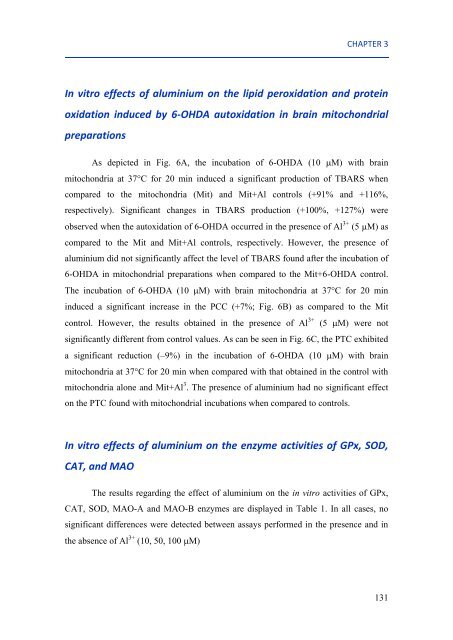Mechanisms of aluminium neurotoxicity in oxidative stress-induced ...
Mechanisms of aluminium neurotoxicity in oxidative stress-induced ...
Mechanisms of aluminium neurotoxicity in oxidative stress-induced ...
Create successful ePaper yourself
Turn your PDF publications into a flip-book with our unique Google optimized e-Paper software.
CHAPTER 3<br />
In vitro effects <strong>of</strong> <strong>alum<strong>in</strong>ium</strong> on the lipid peroxidation and prote<strong>in</strong><br />
oxidation <strong>in</strong>duced by 6-OHDA autoxidation <strong>in</strong> bra<strong>in</strong> mitochondrial<br />
preparations<br />
As depicted <strong>in</strong> Fig. 6A, the <strong>in</strong>cubation <strong>of</strong> 6-OHDA (10 �M) with bra<strong>in</strong><br />
mitochondria at 37°C for 20 m<strong>in</strong> <strong>in</strong>duced a significant production <strong>of</strong> TBARS when<br />
compared to the mitochondria (Mit) and Mit+Al controls (+91% and +116%,<br />
respectively). Significant changes <strong>in</strong> TBARS production (+100%, +127%) were<br />
observed when the autoxidation <strong>of</strong> 6-OHDA occurred <strong>in</strong> the presence <strong>of</strong> Al 3+ (5 �M) as<br />
compared to the Mit and Mit+Al controls, respectively. However, the presence <strong>of</strong><br />
<strong>alum<strong>in</strong>ium</strong> did not significantly affect the level <strong>of</strong> TBARS found after the <strong>in</strong>cubation <strong>of</strong><br />
6-OHDA <strong>in</strong> mitochondrial preparations when compared to the Mit+6-OHDA control.<br />
The <strong>in</strong>cubation <strong>of</strong> 6-OHDA (10 �M) with bra<strong>in</strong> mitochondria at 37°C for 20 m<strong>in</strong><br />
<strong>in</strong>duced a significant <strong>in</strong>crease <strong>in</strong> the PCC (+7%; Fig. 6B) as compared to the Mit<br />
control. However, the results obta<strong>in</strong>ed <strong>in</strong> the presence <strong>of</strong> Al 3+ (5 �M) were not<br />
significantly different from control values. As can be seen <strong>in</strong> Fig. 6C, the PTC exhibited<br />
a significant reduction (–9%) <strong>in</strong> the <strong>in</strong>cubation <strong>of</strong> 6-OHDA (10 �M) with bra<strong>in</strong><br />
mitochondria at 37°C for 20 m<strong>in</strong> when compared with that obta<strong>in</strong>ed <strong>in</strong> the control with<br />
mitochondria alone and Mit+Al 3 . The presence <strong>of</strong> <strong>alum<strong>in</strong>ium</strong> had no significant effect<br />
on the PTC found with mitochondrial <strong>in</strong>cubations when compared to controls.<br />
In vitro effects <strong>of</strong> <strong>alum<strong>in</strong>ium</strong> on the enzyme activities <strong>of</strong> GPx, SOD,<br />
CAT, and MAO<br />
The results regard<strong>in</strong>g the effect <strong>of</strong> <strong>alum<strong>in</strong>ium</strong> on the <strong>in</strong> vitro activities <strong>of</strong> GPx,<br />
CAT, SOD, MAO-A and MAO-B enzymes are displayed <strong>in</strong> Table 1. In all cases, no<br />
significant differences were detected between assays performed <strong>in</strong> the presence and <strong>in</strong><br />
the absence <strong>of</strong> Al 3+ (10, 50, 100 �M)<br />
131

















